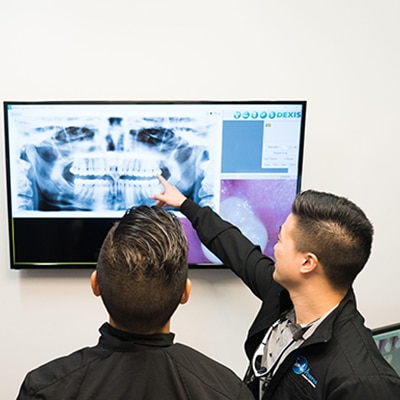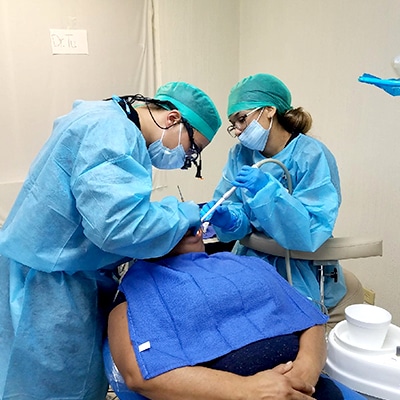
While tooth sensitivity is common after a filling and typically fades within weeks, there are exceptions. If you experience extreme pain, or if the discomfort is accompanied by other symptoms like fever, redness, or swelling, be sure to call your dentist right away. This blog post dives into the causes of tooth sensitivity after fillings, ways to manage it, and when to seek professional attention. We’ll also explore other potential reasons for tooth sensitivity.
What should I expect after a filling?
A dental filling fixes a cavity by removing the decayed material and filling the hole with a replacement material. Here’s a walk-through of the procedure and what to expect afterward:
The Filling Process:
- Getting Numb: Your dentist will inject an anesthetic to numb the area around the tooth, making the procedure comfortable.
- Cleaning Out Decay: The dentist uses a drill or other instruments to remove the decayed area of your tooth.
- Filling the Cavity: Once the decay is removed, the dentist fills the space with a long-lasting material like gold, amalgam, composite resin, or porcelain.
After Your Filling:
- Numbness and Discomfort: For a few hours after the procedure, your face might feel numb, tingly, itchy, or swollen. You might also have difficulty eating, swallowing, talking, or moving your face muscles normally. This is temporary and will subside as the numbing wears off.
- Eating and Drinking: Your dentist might advise waiting a few hours before eating or drinking to avoid accidentally biting your tongue or cheek while numb.
- Adjusting to the Filling: For a few days or weeks, you might experience new sensations as you adjust to the filling in your tooth.
- Sensitivity: It’s common to feel some sensitivity or discomfort in the filled tooth or surrounding area during this time. This sensitivity usually goes away within a few weeks.
What does sensitivity after a filling feel like?
While dental fillings are a common and effective way to treat cavities, they can sometimes lead to temporary tooth sensitivity. This sensitivity typically feels like a brief, uncomfortable sensation in the filled tooth or surrounding area, triggered by certain things. Here are some common triggers to be aware of:
- Temperature: Cold foods and drinks (like ice cream or iced beverages) or hot drinks (like coffee or tea) can cause a jolt of pain.
- Air Exposure: Breathing in cold air, especially through your mouth, might trigger sensitivity.
- Sweet or Acidic Foods: Candy, fruits, juices, and coffee can irritate the filled tooth.
- Biting Down: Chewing, particularly on hard foods, can sometimes cause discomfort.
The good news is that this sensitivity is usually temporary and often goes away within a few weeks as your tooth adjusts to the filling.
If you’re experiencing tooth sensitivity after a filling, here are some tips to manage it:
- Use pain relievers: Over-the-counter pain relievers like ibuprofen or acetaminophen can help manage discomfort.
- Apply a cold compress: Hold a cold compress to the outside of your cheek near the filled tooth to reduce inflammation.
- Use toothpaste for sensitive teeth: Look for toothpaste formulated for sensitive teeth, which can help lessen discomfort.
- Be gentle when brushing: Use a soft-bristled toothbrush and avoid brushing too vigorously, especially around the filled tooth.
If you experience extreme pain, or if the discomfort is accompanied by other symptoms like fever, redness, or swelling, be sure to visit your nearest dental office right away.
Why Does Sensitivity Happen After Fillings?
While it’s common to experience some sensitivity after a filling, other potential causes should be addressed. Here’s why it occurs:
- Nerve Irritation: The filling process can irritate or inflame the nerve inside the tooth, particularly with deep fillings that are close to the nerve endings, leading to discomfort.
- Natural Protection: Normally, the tooth’s outer layers, enamel, and cementum protect the nerve from irritation. However, fillings can disrupt this protective barrier.
- Healing Process: Fortunately, as the nerve heals from this irritation, sensitivity should diminish within a few weeks to months. Once fully healed, there should be no discernible difference between the filled tooth and the others.
Ignoring a toothache following a filling is not advisable. Although some level of discomfort is to be expected, ongoing or intense pain may point to an underlying problem. By recognizing the reasons and promptly consulting a trusted restorative dentistry expert like Dr. Vuong for the most suitable types of fillings, you can alleviate the pain and avoid potential complications. It is crucial to remember the significance of prioritizing your oral health.
Types of Best Filling
There isn’t a single “best” type of filling, as the optimal choice depends on your specific circumstances. Here’s a breakdown of popular options to discuss with your dentist:
- Composite resin: Tooth-colored and favored for front teeth for a natural appearance. May need replacement sooner than other types.
- Silver amalgam: Durable and cost-effective, but noticeable due to its dark color. Less commonly used nowadays.
- Ceramic: Highly aesthetic and resistant to stains, making it ideal for front teeth. May be pricier than composite.
- Gold: Extremely strong and long-lasting, but the most expensive and conspicuous choice.
When considering these options, discuss factors such as:
- Cavity location: Is it in a front or back tooth?
- Decay severity: How much of the tooth structure requires repair?
- Your budget and insurance coverage
- Aesthetic preferences: How important is a natural appearance to you?
By collaborating with your trusted Katy dentist, you can select the filling that best fits your needs for a healthy and attractive smile.









